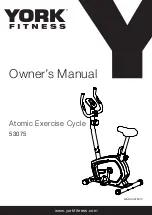
10
2.
Position the front stabiliser bar with wheels (14),
paying attention to the red dots and with the wheels
facing forwards, as shown in Fig.2, insert the bolts
(8), fit the flat washers (7) and cap nuts (6) and
tighten with a torque wrench applying a torque of 20
Nm.
FITTING THE PEDALS.-
The assembly instructions for the pedals must be
followed to the letter, fitting these incorrectly could
damage the screw thread on either the pedal or the
crank.
Right and left refer to the position that the user adopts
when sitting on the saddle to do the exercises.
With a clean cloth, clean the threads of the pedal.
Apply Loctite 242 (not supplied) to the pedal
threads, not applying to the first thread, Fig 8. Force
the Loctite into the threads to fill all the gaps. Apply
the product to the threads of the crank as well.
Tighten with a torque wrench applying a torque of
46 Nm. Fig.9.
The right-hand pedal (9R), marked with the letter (R),
screws onto the right-hand crank, also marked with an
(R), in a clockwise direction.
The left-hand pedal (9L), marked with the letter (L),
screws onto the left-hand crank, also marked with
an (L), in an anti-clockwise direction.
ATTACHING THE SADDLE.-
Fit the saddle bracket (1), Fig.4, onto the horizontal
saddle tube (43), as shown in Fig.4, fit the saddle
into position and tighten the nuts on the bracket
securely. To tighten the nuts is recommended to
use two wrenches for M8 nuts (not supplied).
Next insert the horizontal saddle tube (43) through
the hole on the saddle post (39), Fig.4, position it
correctly and tighten the knob (2), Fig.4.
Insert the saddle post (39) into the boss on the
main body (A), position it correctly and tighten the
saddle post by using the adjustment knob (2A),
Fig.4, turning it clockwise.
ADJUSTING THE SADDLE HEIGHT.-
Loosen the saddle post adjustment knob (2A)
slightly by turning it anticlockwise, Fig.5, move the
saddle to a position comfortable for doing exercise
and then tighten the adjustment knob (2A) securely
by turning it clockwise.
Stay within the references without going beyond the
“MIN INSERT” mark.
HORIZONTAL ADJUSTMENT OF THE SADDLE.-
Loosen the knob (2) slightly by turning it
anticlockwise, Fig.5, move the saddle to a position
comfortable for doing exercise and then tighten the
knob (2) securely by turning it clockwise.
Stay within the references without going beyond the
“MIN INSERT” mark.
FITTING THE HANDLEBAR.-
Position the handlebar (20) on the handlebar stem
(21), Fig.5, tighten the knob (17) and then insert the
handlebar stem (21) into the hole on the main body
(A), Fig.5. Position it correctly and then tighten knob
(17B) by turning it clockwise.
ADJUSTING THE HANDLEBAR HORIZONTALLY.-
Position the handlebar (20) at a comfortable
distance for doing exercise, now tighten knob (17)
securely, Fig.5.
ADJUSTING THE HANDLEBAR VERTICALLY.-
Position the handlebar (20) at a comfortable
distance for doing exercise, now tighten knob (17B)
securely, Fig.5.
Stay within the references without going beyond the
“MIN INSERT” mark.
FITTING THE ELECTRONIC MONITOR.-
H920E
Place the monitor (500N) in the direction of the
arrow sliding the monitor on the holding plate (M)
Fig.5A and fix it with the screw (71).
Connect the terminal (502N) of the cable sticking
out of the main body (A) in terminal (72) of the rear
part of the monitor (500N) Fig.5A.
EXERTION SETTINGS.-
To provide an even level of exertion during
exercise, this appliance is equipped with a
tensioning control (22), located on the stem of the
main body (A), Fig.6. This provides various exertion
settings when turned clockwise.
To increase pedal resistance turn the tensioning
control (22) clockwise (+) until the exertion level
best suits your exercise requirements.
To reduce pedal resistance turn the tensioning
control (22) anticlockwise (-).
During exercise the flywheel will get hot due to the
braking effect, so when you have finished
exercising it is advisable to set the tensioning
control (22) to minimum in order to help stop the
brake shoe from hardening.
Important:
This tensioning control (22) is equipped with an
emergency braking system which, when applied
with force (as shown by the arrow in Fig.6,
produces a much sharper braking effect.
LEVELLING.-
Once the unit has been placed into its final position,
make sure that it sits flat on the floor and that it is
level. This can be achieved by screwing the
adjustable feet (10) up or down, as shown in Fig.6.











































